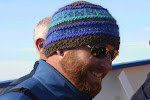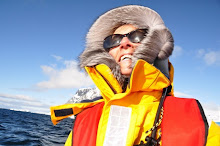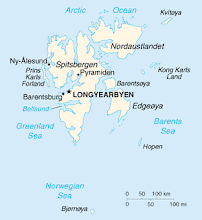
It never goes below the horizon, but looks like this through much of the 'night.'

Finally, we saw signs.


Then...


These are happy bears, well fed and in the ice where seal is plentiful.

Mother and cub.


Later on, a disturbing and chilling sight, a rare encounter with polar bear cannibalism. Even the long time naturalists had only heard of this yet never seen it. A polar bear eating one of its own is a desperate bear. Polar bears eat blubber. Yet a lean polar bear will not have much blubber on it. We could tell the head had been eaten in back, where the fatty brain is. Here, it's eating a small layer of fat in the lower belly.

This was the sight I feared most, a very lean and lethargic bear, too far south of the ice to ever catch up to find food. It had eaten a small pile of rotting blubber, from a beached whale going back two years. They'll eat anything to fill their bellies, rotting or otherwise. Generally their metabolism slows down to conserve energy. At this stage the ice was about 200 miles north, too far for the bear to swim to catch up to the ice. I called this the Sad Bear. It barely moved the whole time we watched it. Skinny, lethargic, weak and dirty, it most likely didn't make it.

Too close for comfort! Who was more surprised, Phil or the massive male just emerged from the water?! Phil held his ground without threatening or retreating and eventually the male edged back into the water. They can and do, do terrible damage to our zodiacs with their tusks should we get too close. We don't even put zodiacs in the water when near walrus beaches.



















No comments:
Post a Comment